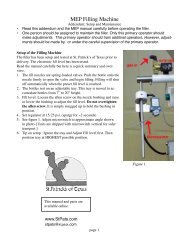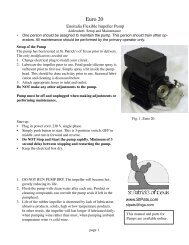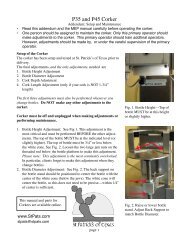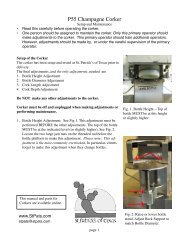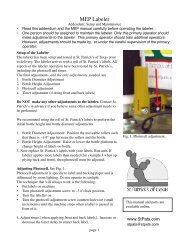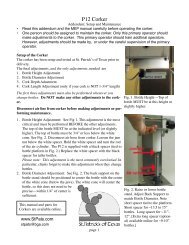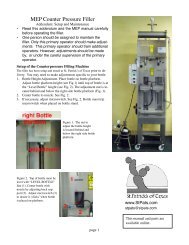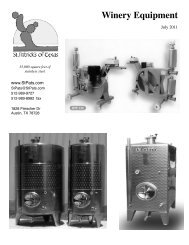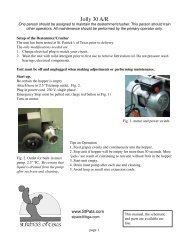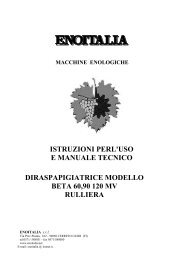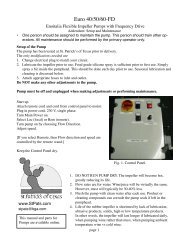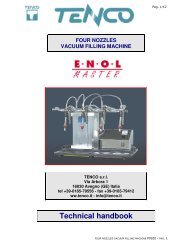Etc220 MEP Labeler - St. Patrick's of Texas
Etc220 MEP Labeler - St. Patrick's of Texas
Etc220 MEP Labeler - St. Patrick's of Texas
You also want an ePaper? Increase the reach of your titles
YUMPU automatically turns print PDFs into web optimized ePapers that Google loves.
Periodic Maintenance. Keep labeler clean and dry. Do not store in humid or wet area.. Remove front cover and lubricate the chain annually. Aerosol spray <strong>of</strong> lithium grease works well.DO NOT. DO NOT use OZONE to clean a labeler. Ozone will destroy all rubber and plastic components andshould NEVER be used on equipment with rubber or plastic components.. DO NOT use a HOSE or PRESSURE WASHER to clean a labeler. Simply wipe down with cleandamp cloth. Pressure washers should NEVER be used on equipment with bearings or electrical components.3. DO NOT use METABISULFITE (or any harsh chemicals) for cleaning or sanitizing. Metabisulfite isnot a sanitizer nor a cleaner and should NEVER be used as such. Metabisulfite is corrosive to mostmetals including stainless steel.Problems and SolutionsProblem: Nothing happens when bottle is placed on bottle stand.Solution 1: Emergency <strong>St</strong>op button is pushed in. Pull it out.Solution 2: Turn <strong>of</strong>f unit and wait 30 seconds before turning it backon.Problem: Three or more labels are applied per cycle.Solution 1: Adjust photocell. If room lighting has changed, the photocellmay need to be readjusted.Solution 2. Do not operate in direct sunlight---this blinds the photocell.Problem: Bottle spins out from between the rollers.Solution: Moveable rollers must be moved closer to the bottle---gap~1/4”.Problem: Black rubber sleeve moves up (or down) on roller.Solution: See Fig. 2. Place compressed air nozzle between sleeveand white roller. Pull up or down on rubber sleeve while applyingcompressed air to reposition the black rubber sleeve.Fig. 2. Use compressed air toreposition black sleeve.page
M.E.P. - operator's handbook - Etc 220 labelling machineCONDITIONS OF SALE AND WARRANTY1. Read carefully this operator's handbook before operating our Etc 220 labellingmachine.2. M.E.P. guarantees his Etc 220 labelling machine in case <strong>of</strong> breakages caused byfaulty components or incorrect assembly.3. Our Etc 220 labeling machine has a 12-month warranty. 12 month period begins on shippingdate from <strong>St</strong>. Patrick’s <strong>of</strong> <strong>Texas</strong>. This guarantee is valid only for the first owner <strong>of</strong> thecorking machine.4. Warranty only consists in replacing the damaged parts and it does include neitherrefunds for losses caused by the shutdown <strong>of</strong> the machine nor any cost <strong>of</strong> labour orany transport cost to send the filling machine to a repair shop.5. Any repair or modification made to the machine by unauthorized personnel will makethe warranty void.6. We cannot be held responsible for damages due to incorrect use <strong>of</strong> the labelingmachine, or failure to carry out maintenance and lubrication, or problems or damageincurred during transport.7. M.E.P. reserves the right to introduce changes without previous notice to the Etc 220labelling machine; however, the supply <strong>of</strong> spare parts <strong>of</strong> the previous models will beguaranteed.INDEX1 ............................ Description <strong>of</strong> the Etc 220 labelling machine2 ............................ Technical details3 ............................ Instructions for use4 ............................ Operating directions5 ............................ Faults and remedies check list6 ............................ MaintenanceElectric system <strong>of</strong> the Etc 220 labelling machine1
M.E.P. - operator's handbook - Etc 220 labelling machine1. DESCRIPTION OF THE Etc 220 LABELLING MACHINEOur Etc 220 semi automatic labelling machine makes it possible to use self-stickinglabels and allows you to put front and back labels on cylindrical bottles.Our Etc 220 labelling machine is almost entirely made <strong>of</strong> stainless steel or syntheticmaterials (such as delrin or rubber) which are resistant to wear; the only parts made <strong>of</strong>carbon steel are the internal mechanisms but they are galvanized.All moving mechanisms are supported by ball-recirculating elements in order toguarantee both a higher precision <strong>of</strong> functioning and a higher resistance to wear.SAFETY SYMBOLS:General dangerCaution: refer to the operator's handbookCaution: 230 Volt tension.2
M.E.P. - operator's handbook - Etc 220 labelling machineCaution: rotating gears. Severing <strong>of</strong> fingers.2. TECHNICAL DETAILSThis labelling machine is suitable for self-sticking labels located on a continuous bandwhich is wound round on a bobbin. It is possible to put a single label or both front andback labels but they have to be located on the same band.The labels regard to the supporting band have to be disposed, as follows (see picture 1):A dimension: more than 40 mmB dimension: more than 40 mmC dimension: maximum 25 mmD dimension: more than 3 mmE dimension: maximum 25 mmF dimension: maximum 160 mmG dimension (space between labels' band and lower part <strong>of</strong> the second printing line): thestandard version is preset at 22 mm3
M.E.P. - operator's handbook - Etc 220 labelling machineRetroetichettaEtichettaRetroetichettaEtichettaFEGDCBAPicture 1.HIMGLPicture 2.The stamp has the following lay-out (see picture 2):types' height 3 mm (different types can be requested when placing the order)possibility to print on 3 linesH dimension and I dimension: preset at 6,25 mm (these dimensions are referred to theprinting lines' barycentre)L dimension: preset at 35 mmtypes' width: 3 mmpossibility to fit up to 11 types into each line4
M.E.P. - operator's handbook - Etc 220 labelling machineM dimension: preset at 15,5 mmWhen a types' height different from 3 mm is requested, the M dimension must berecalculated on the basis <strong>of</strong> the new types' height.Bobbin's maximum external diameter: 200 mmInner diameter <strong>of</strong> the spool's bobbin: 65 - 75 mmBobbin wound round counterclockwise (bobbin's unwinding on the machineclockwise), labels on the external part <strong>of</strong> the bobbinCylindrical bottlesBottles' diameter between 60 mm and 112 mmOur Etc 220 labelling machine is supplied as a bench version; as an option, it can beprovided with a stainless steel wheeled support.Etc 220 labelling machine:height: 620 mmwidth: 470 mmfront length: 850 mmweight: 60 kgEtc 220 labelling machine with a stainless steel wheeled support:height: 1120 mmwidth: 470 mmfront length: 850 mmweight: 75 kgSingle-phase feeding: 110 Volt, 60 Hz5
M.E.P. - operator's handbook - Etc 220 labelling machinerotation speed (two motors): 1380 r.p.m.power: 0.3 KWThe labelling time, that is the time between the bottle being located on the bottle platformand the labelled bottle being taken back, is 3,5 seconds.3. INSTRUCTIONS FOR USEIn our Etc 220 labelling machine bottles must be placed vertically, so that it starts asensor with a tongue which makes the machine start (see picture 3, starting sensor).Functioning consists in the mobile roller coming near and closing the bottles inside threerubber rollers. Bottles start rotating while the band where labels are located is drawn andmade pass on a blade which makes it turn 360°. This makes a label come <strong>of</strong>f the band (ora couple <strong>of</strong> labels, front-and back labels) and it being applied on the bottle. Now themobile roller goes back, the labelled bottle can be taken <strong>of</strong>f and a new one inserted.6
M.E.P. - operator's handbook - Etc 220 labelling machineMobile roller’s Main Secondary entrainment Final Band’sfastening knobs entrainment entrainment spool fasteningroller roller knobMobileroller<strong>St</strong>artingsensorBottle Label’s <strong>St</strong>amping <strong>St</strong>arting Adjusting knob <strong>of</strong> thePlatform blade device spool label’s unwindingPicture 3.7
M.E.P. - operator's handbook - Etc 220 labelling machine4. OPERATING DIRECTIONSThe Etc 220 labelling machine must be placed on an even ground, in a lit up room andfar enough from other machines.This machine must be used by an operator at a time and when the machine is operatingnobody else should be near.First <strong>of</strong> all, adjust the position <strong>of</strong> the mobile roller (see picture 3, mobile roller'sfastening knobs). To do this, loosen the knobs which keep it stationary (see picture 2,mobile roller's fastening screws) and arrange this roller in a way that it is easy to put thebottles in and take them <strong>of</strong>f. It is advisable to place a bottle on the two fixed rollers andmove the third roller up to 3 mm near the bottle. To leave less space would make itdifficult to position the bottles and take them <strong>of</strong>f, whereas a larger space would not assurethe right closing and labels could be applied irregularly.PICTURE 4Green/red lightAdjusting screwPicture 4.In order to avoid anomalies in functioning, check the right degree <strong>of</strong> sensitivity <strong>of</strong> thephotocell. To do this, insert the band's edge with a label on it into the photocell's fork.When the band without any label on it is inserted, the green warning light located on the8
M.E.P. - operator's handbook - Etc 220 labelling machinelower part <strong>of</strong> the photocell turns on; whereas, when the band with labels on it is inserted,the red warning light turns on (see picture 4). In case this does not happen, the adjustingscrew must be screwed or unscrewed. When it is turned clockwise, the photocell's degree<strong>of</strong> sensitivity increases; so, if when inserting the band without any label on it the greenwarning light does not turn on, then the adjusting screw must be screwed.Fastening cone<strong>St</strong>arting spoolDelay Green Quick stop Switch <strong>of</strong> the Switch <strong>of</strong> the Generalwarning push-button second label stamping device switchlightPicture 5.9
M.E.P. - operator's handbook - Etc 220 labelling machineAfterwards, place the labels' band on the machine. To do this, remove the fastening conefrom the starting spool (see picture 5), insert the labels' bobbin and relocate this coneagain using some strength downwards so that the bobbin adheres to the shaft.The band must be located on the machine so that it follows the way <strong>of</strong> picture 6.Labels must pass between two rollers which are kept pressed one against the other by aspring which is a little stiff (see picture 6, entrainment rollers).To carry out this operation, the two rollers must be spaced out and the labels' band mustbe put inside them, paying attention to keep it in line with the height <strong>of</strong> the starting-andfinal spool as far as possible.Main entrainment Secondary entrainment Final spoolrollerrollerBottle Photocell Blade Label <strong>St</strong>arting spoolPicture 6.10
M.E.P. - operator's handbook - Etc 220 labelling machineNow connect the machine to the current feeding and turn the main switch to position "1";the green indicator will turn on (see picture 5). The machine is ready for work and it isenough to put a bottle inside the three rollers to have it labelled.CAUTIONBefore starting work check that on the machine there aren't any spanners or otherfittings used to carry out the necessary adjustments. Once a bottle is placed on thebottle platform keep your hands away from the machine and move them near onlyonce the bottle is labelled.Back labelBottle seen from aboveFront labelPicture 7.In case one wants to apply a second label too, one has to move the little lever located atthe front <strong>of</strong> the control box (see picture 5). Moving this lever makes a little green warninglight turn on (it is smaller than that <strong>of</strong> the main switch). Now lay a bottle and the secondlabel will be applied.If you want to put both front-and back labels, and the two labels are not placed correctly,adjust the special adjusting delay (see picture 5).Refer to the plan <strong>of</strong> picture 7: by turning the delay's knob clockwise, the time betweenthe application <strong>of</strong> the two labels increases; so, the back label will be moved towards the11
M.E.P. - operator's handbook - Etc 220 labelling machinedirection <strong>of</strong> the arrow, that is counterclockwise. In other words, if you look at the bottlefrom the front and the space on the right between front-and back label is less than that onthe left, the delay's knob must be moved clockwise.Ink basinTypes holding platePicture 8.In case the labelling machine is equipped with an optional stamping device, at the front<strong>of</strong> the control board there are two little levers with their respective green warning light.The second lever serves to turn on the stamping device.Once the labels are applied, the stamping device is started automatically by putting abottle on the bottle platform and it prints on a part <strong>of</strong> the label when it is still on theblade.It is possible to write up to three lines by laying on the holding plate (see picture 8) thetypes the machine is equipped with. To lay the types, one can start the stamping device(by putting a bottle on the bottle platform, for example) and stop it by pressing the quickstoppush-button in the middle <strong>of</strong> its run. Now it is possible to arrange the stamp wantedusing the special tweezers. The types have a dovetail; so, to arrange them on the holding12
M.E.P. - operator's handbook - Etc 220 labelling machineplate, it is necessary to insert them sideways and drag them to the spot wanted using thetweezers.This labelling machine is equipped with five sets <strong>of</strong> numerical types from "0" to "9" andtwo indelible ink basins.Before starting work, open one <strong>of</strong> the two ink basins, place it in the upper part <strong>of</strong> thestamping device (see picture 8) and insert it under the plate by pushing it until it getsstuck.In the rest position the types holding plate is in touch with the ink basin. During itsworking run the types holding plate moves, rotates, stamps and goes back to its startingposition, so that it closes and prevents the ink form staying in touch with the air for a longtime. It is easier to place the basin when the stamping device is in the middle <strong>of</strong> its run(see picture 8).At the end <strong>of</strong> work, clean the stamp's types using blotting paper, take <strong>of</strong>f the ink basinand close it by means <strong>of</strong> the special ink-pad. This operation has to be carried out whenthe stamping device is in the middle <strong>of</strong> its run, too.The position <strong>of</strong> the stamping device can be adjusted in the same direction as the label'sblade by changing the position <strong>of</strong> its screws and moving it to a different one among thefour longitudinal longholes located on the machine's plane. This adjustment will probablybe necessary because if the label's width changes, the respective position between stampand label changes, too.Eventually, it is possible to adjust up to 25 mm the height <strong>of</strong> the label on the bottle. Todo this, the bottle platform must be screwed down or unscrewed (see picture 3): this isthreaded and it will go up or down and make the label's height change.CAUTIONBefore intervening on the machine always bring the starting switch back to the "0"position.13
M.E.P. - operator's handbook - Etc 220 labelling machine5. FAULTS AND REMEDIES CHECK LISTIn case labels are applied slightly oblique on the bottles, you must check that the band'slower part is in contact with the edge <strong>of</strong> the label's blade (see picture 3). If it is not so,separate a little the two rollers using some strength and adjust the band's position. Thewhite plastic roller can be moved, whereas the rubber one is fixed.In case after placing a bottle on the bottle platform the machine does not start, check thatthe quick-stop pushing button was not pressed (see picture 5). In that case, turn itclockwise and try again. If the problem persists check that the starting sensor (see picture3) is properly started by the bottle; if it is not so, move it upwards by loosening therespective screws.If after a bottle has been labelled the labels' band is not stretched, one can try to screwdown the fixing cone a little bit more (see picture 5). In case the problem persists, screwdown the adjusting knob <strong>of</strong> the labels' unwinding (see picture 3). It is better not to screwdown this knob too much; turn it once, then try to label again. Only afterwards, ifnecessary, screw it down more.If for whatever reason should come a strange noise from inside the machine, pressimmediately the quick-stop push-button (see picture 5). You could try to spot theproblem by taking <strong>of</strong>f the back panel <strong>of</strong> the machine, but it is better not to go on tryingtoo long and contact an authorized person.6. MAINTENANCEAt the end <strong>of</strong> work it is advisable to remove from the rubber rollers any glue residualproducts. They are unlikely to form, but if they are neglected, after some time, form14
M.E.P. - operator's handbook - Etc 220 labelling machineincrustations hard to be removed. At the end <strong>of</strong> work always turn the general switch tothe "0" position (see picture 5) and disconnect the current feeding cable.When using the machine after a long stop, it is advisable to lubricate all moving parts.To do this, remove the back panel <strong>of</strong> the machine and lubricate the drive chain, the linearguides and all the moving parts using grease.15
M.E.P. - operator's handbook - Etc 220 labelling machineELECTRIC SYSTEM OF THE Etc 220 LABELLING MACHINE16



